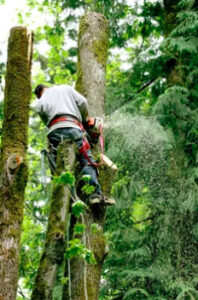Tree Trimming – A Necessary Horticulture Technique
Tree trimming is necessary to ensure that your trees and shrubs grow properly. It involves removing dead parts of the plant and thinning out overcrowded areas. You also want to eliminate branches acting as obstructions – blocking the sidewalk, hanging over your driveway, or rubbing against your roof. To do this, use a stick.
Regarding tree trimming, professionals rely on various equipment to do the job quickly and safely. These tools include shears, chainsaws and pruning gloves, among other items. A telescoping ladder is an essential piece of equipment for this task, as it allows a professional to reach higher areas of a tree without having to climb it directly. A mini skid steer is another useful tool for this job, as it can easily fit through 35-inch gates. It allows a professional Tree Service Irvine CA to easily access residential neighborhoods.
A quality pair of loppers is also necessary, as they can make precise cuts for smaller branches and vines. If you are working on a large property with lots of trees, consider purchasing or renting a high-quality pair of telescoping shears, as these will be able to reach much further than traditional shears that do not have a telescoping handle. For large-scale tree trimming projects, a gas-powered chipper is essential for processing the larger branches and leaves into valuable mulch.
Although the terms pruning and trimming are often used interchangeably, they have very different purposes. While trimming is mainly concerned with aesthetics, pruning is meant to promote a tree’s health. If both are not conducted properly, it can lead to serious problems for the health and appearance of the plant.
Keeping your equipment in great condition is important when it comes to trimming and pruning trees. By adding Business Equipment Protection to your policy, you can ensure that the equipment you use for these tasks is covered in case of damage or loss. This is an essential addition to any tree trimming company’s insurance policy. This coverage includes accidental damage to the equipment, as well as theft and vandalism. Contact us to learn more about adding this optional coverage to your policy.
Techniques
Tree trimming is a necessary horticulture technique that can promote healthy growth and enhance the aesthetics of trees, hedges, and shrubs. It can also help prevent potential safety hazards that could result from sagging or overhanging branches and limbs. Properly conducting this process requires knowledge of specific tools, proper timing, and the correct technique. If you are not an experienced professional, it is best to leave this task to a trained arborist.
When a professional conducts tree trimming, he or she will use multiple types of equipment to cut the desired length of branches and limbs. These can include hand tools, such as branch shears or loppers, or power tools, such as pole pruners or chainsaws. For safety reasons, it is important to know how to properly operate all of these different tools before you attempt any trimming.
A key factor in tree trimming is reducing the overall density of a tree. This helps to improve air circulation, allow sunlight to reach more areas of the landscape, and reduce stress on individual tree limbs caused by wind, snow, gravity, or ice. Using a tree trimming technique known as crown reduction, a skilled tree service can carefully thin a tree canopy without damaging its structure.
Another essential aspect of tree trimming is removing dead or diseased limbs and removing them before they cause a hazard. If left unattended, a damaged or dead limb can fall and damage your home or property. By removing these branches as soon as possible, you can protect your property and your family.
A good time to trim a tree is in the spring or winter, before it starts growing. This way, you can be sure that the new buds and leaves are on their way to a lush and vibrant growth. When it comes to trimming a hedge or shrub, the best time is during the flowering cycle. If you’re pruning for aesthetics, a hedge or shrub should be trimmed at least twice per year to ensure that it maintains its shape and size. To avoid damaging the plant, always use sharp, clean tools and remember to cut outside of the branch bark ridge. This will help to prevent unnecessary wounds, which can lead to rot or insect infestation.
Safety
When trimming trees, workers must be mindful of safety precautions. They should never work alone, and they must make sure that their equipment is in good working condition. They should also use proper ladders and wear appropriate personal protective equipment. This includes a hard hat and face shield to protect their heads and eyes from falling debris, and thick work gloves to avoid cuts and punctures from sharp branches and twigs. In addition, they should wear long pants and sleeves to protect their bodies from splinters. Finally, they should wear closed-toe shoes to provide traction on slippery surfaces.
Trimming trees is a dangerous activity, especially for inexperienced tree trimmers. Accidents involving falling trees or branches can injure or kill people and damage homes and other structures. In addition, contact with overhead power lines can lead to electrocution, which is the leading cause of fatal injuries for tree trimmers.
In order to reduce these hazards, employees must survey the work area prior to starting trimming and remove or mark any hazard areas. They should follow ANSI standards and the recommendations of OSHA when using power tools. They should also assume that all power lines are energized until they have been verified as de-energized.
When pruning, employees must take into account the health and growth history of each tree. A healthy tree can usually withstand heavy trimming without significant damage. However, a tree with pre-existing stress or a high risk for disease can be irreparably damaged by removing too much foliage.
When removing large branches, employees should cut them at the point of origin. This will help to prevent the spread of disease and other problems caused by improper wound closure. Finally, workers should always check the ground for any fallen branches or twigs before leaving the job site. This will ensure that they do not trip and fall or injure themselves while cleaning up. In addition, they should check for any potential structural defects in the remaining structure of each tree before continuing their work. Finally, they should inspect the safety equipment at the beginning and end of each shift to ensure that it is in good working order.
Aesthetics
Trees are a valuable asset to any property, adding curb appeal while providing shade and improving air quality. However, if left unattended, trees can become overgrown and unsightly. This is where tree trimming comes in, a process that involves the removal of unwanted branches and leaves to promote healthy growth. Tree trimming can also be used to maintain the shape of a tree or shrub.
While many homeowners take on the task of pruning their own trees, hiring a professional arborist is an excellent way to ensure that your landscape looks its best. A trained arborist will know how to trim your trees safely and effectively without damaging them.
In addition, a professional will have access to tools and equipment that are typically not available to homeowners, such as specialized pruning shears and loppers. They will also have a better understanding of the health and aesthetics of different types of trees, and they will be able to recommend the right kind of trimming for each tree in your yard.
Aesthetic tree trimming is important because it helps ensure that a tree is healthy and attractive. It can also help prevent damage to the property or people nearby, such as by removing dead or damaged branches. If you want your trees to look their best, it’s important to hire a qualified tree service in Grapevine, TX.
To prune a tree properly, it’s important to understand the branch collar, a swollen area that connects the trunk to the branch. Make sure that any cuts you make are made just outside the collar, to avoid tearing or damaging the bark. Also, be sure to cut away any stubs that remain, as these can attract pests and cause disease.
It’s also a good idea to consider the season when you trim a tree. In general, it’s best to do this during the winter or early spring, when the tree is dormant and less likely to experience stress from pruning. However, some trees (such as maples and birches) are prone to bleeding sap if they’re trimmed in the winter, so it’s generally best to wait until late spring or summer to trim these species.
